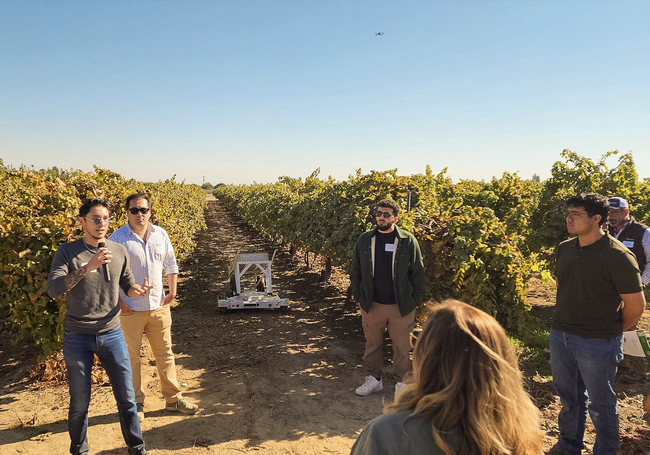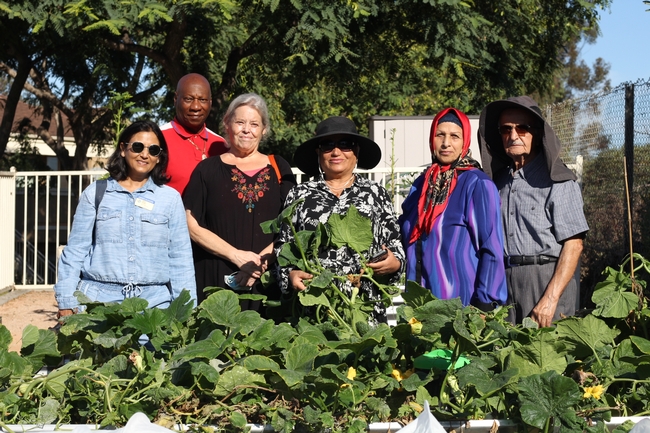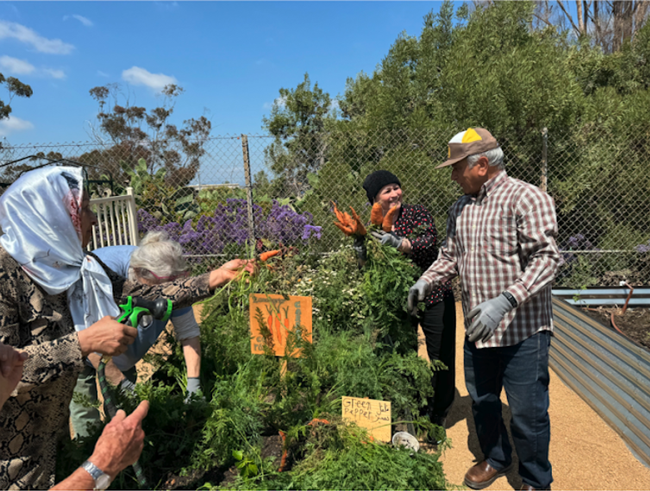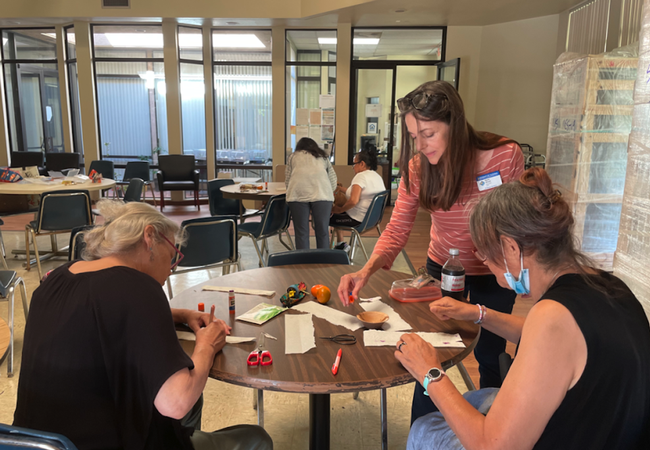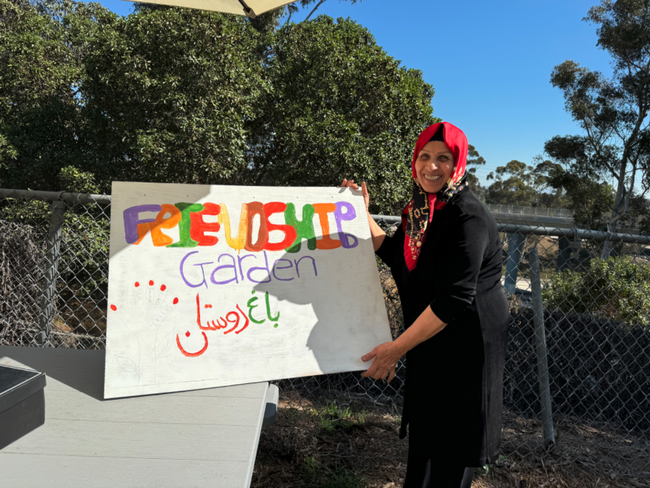News stories
Startups get help to speed new tech to California farmers
Program that helps startups and companies scale technologies for California agriculture accepting applications
UCANR Innovate, the innovation arm of the University of California Agriculture and Natural Resources, has opened applications for its VINE Connect program. Developed in partnership with Farmhand Ventures, the program empowers startups and established companies to scale their technologies in California, addressing key challenges for the state's farmers. Deadline to apply is Jan. 8, 2025.
California farmers are at the heart of global food production, but staying ahead requires constant innovation. To meet this challenge, VINE Connect bridges the gap between innovation and application by helping entrepreneurs tailor proven technologies for farmers to ease weed control, harvest and other farming tasks.
Each year, the VINE Connect program runs three cohorts, each centered on different focus areas within California agriculture. More than 20 solutions are selected annually to participate in a three-month cohort designed to accelerate market adaptation. Participants benefit from a workshop series on field trial readiness, opportunities to present their technologies during a field demonstration day, and extended network opportunities to connect with key stakeholders in California's agrifood sector. Eligible participants may also qualify for future innovation grants to support technology development, field trials or relocation to California.
"VINE Connect is all about bridging the gap between innovative ideas and the real-world challenges facing agriculture," said Hannah Johnson, industry lead at UCANR Innovate. "We're helping great technologies find their place in California's farms and fields, creating solutions that work for farmers and the entire food system."
"Programs like VINE Connect are critical for supporting entrepreneurs as they adapt their technologies to the unique needs of California's agriculture industry," said Connie Bowen, Founder of Farmhand Ventures. "It's about building solutions that are both impactful and sustainable while ensuring they have the potential to grow and attract future investment."
The VINE Connect program is part of UCANR Innovate's broader initiative, The VINE, which is dedicated to advancing agricultural innovation across California. Through a market-driven approach, The VINE collaborates with farmers, industry leaders and community groups to identify practical challenges and develop targeted solutions specifically for California.
The initiative operates through two complementary tracks: VINE Build and VINE Connect. VINE Build focuses on transforming early-stage University of California prototypes into viable startups, while VINE Connect supports the market adaptation of any proven technologies to meet California's unique agricultural needs. Together, these programs promote collaboration, sustainability and inclusive growth across one of the world's most essential agricultural regions.
"The VINE is about connecting the dots between innovation and agriculture,” said Gabe Youtsey, chief innovation officer at UC ANR and head of UCANR Innovate. “Together, these programs form a complete ecosystem for transforming agricultural challenges into opportunities, helping farmers, startups and communities thrive in California's dynamic landscape."
Applications for the VINE Connect program are open now and will close on Jan. 8, 2025. For more information or to apply, visit https://thevine.io.
UCANR Innovate is the innovation arm of University of California, Agriculture and Natural Resources, dedicated to driving agriculture, food, and biotechnology innovation in California. We connect people, ideas, and resources to tackle real-world challenges and drive progress that empowers entrepreneurs, strengthens industries, and secures a thriving, inclusive future for California's agriculture, its workers and its communities.
Unique conditions in Modoc County drive organic agriculture adaptations
UC Organic Agriculture Institute visits area to hear innovations, needs of local producers
Modoc County, home to 8,500 people and tucked in the remote northeastern corner of California, has been a leader in advancing organic agriculture through its significant ranching and agronomic crop production, namely of potatoes and hay.
In fact, Modoc County is California's number one county for organic beef cattle production (119,782 acres in 2022), and consistently in the top five counties for total harvested certified organic acres in the state, according to the most recent California Department of Food and Agriculture statistics.
“Modoc County farmers and ranchers in many ways exemplify the values of organic agriculture, adapting and tailoring their operations to the contexts of the unique landscapes we live in,” said Laurie Wayne, University of California Cooperative Extension nutrition, community health and food systems advisor for Modoc, Siskiyou and Lassen counties.
This past summer, Wayne and Rob Wilson – UCCE farm advisor and director of the Intermountain Research and Extension Center operated by UC Agriculture and Natural Resources – shared their insights with a visiting team from the UC Organic Agriculture Institute.
Established in 2020 as an institute under UC ANR, OAI was created to develop research, extension and education support for certified, transitioning and aspiring organic farmers and ranchers across California. The OAI team has been visiting different regions to better understand the unique conditions of organic agriculture in those areas.
“These tours are our chance to build relationships with local farmers, partner organizations and colleagues and see how organic agriculture has grown and developed in that specific region,” said Houston Wilson, OAI director. “We also get to learn directly from farmers and ranchers about how regional contexts and community goals influence organic agriculture in their area.”
Modoc County's geography, climate spur adaptive strategies
Wayne, who previously operated a farm in Modoc County and also co-founded the Surprise Valley Saturday Farmer's Market and Modoc Harvest Food Hub, was the perfect person to introduce the OAI team to local agricultural producers.
“I hoped to show our visitors just a glimpse at the many lessons I've learned and inspiration I've gained from the agriculture community in Modoc,” Wayne said.
A common theme across Modoc County is the use of innovative and place-based strategies to farm within diverse ecosystems. For example, extensive rotational grazing is well-suited to the region's vast sage steppes, perennial grasslands and sagebrush ecosystems.
333 Ranch – a third-generation ranch in Lake City owned and operated by Sophie Sheppard, Lynn Nardella, and their son, Jason Diven – raises rotationally grazed beef cattle and calves, hogs and Icelandic sheep and grows organically managed vegetables.
Half of 333 Ranch is under conservation easement to preserve natural resources and wildlife. Their land stewardship practices include working with the Savory Institute – a nonprofit that supports the health of grasslands and the livelihoods of people on those landscapes – on ecological grazing techniques. They also partner with the USDA Natural Resources Conservation Service to convert barbed wire fencing into high tensile fencing for riparian habitat restoration. Sheppard reported that one year after the fence conversion, the ranchers saw nesting Greater Sandhill Cranes and beavers building dams in their creek.
Leah Larsen of Bidwell Canyon Farm in Fort Bidwell said she learned high tunnel production from Sheppard at 333 Ranch and others in the area. High tunnels allow farmers to extend their growing seasons to accommodate diverse crop rotations and opportunities for local food production.
Larsen – who grows vegetables, fruit trees and berries on 1.5 acres (including in two high tunnels) – also raises milk goats and chickens, maintains grazing pasture and operates a farmstay rental. With 11 years of experience farming in Modoc's high desert climate, Larsen offers mentorship to other growers in the region and shares information through channels such as the region's high tunnel Facebook group.
Canyon Creek Ranch in Alturas uses prescribed burns to manage invasive tree species in the sagebrush steppe. Richard (Dick) Mackey and his family operate 3,300 certified organic acres, with 350 head of cattle and 500 acres of hay, pasture and alfalfa. In addition to organic certification, Canyon Creek Ranch is also Ecological Outcome Verification (EOV)-certified; EOV is a program of the Savory Institute that gathers ecosystem data to verify that ranching practices are regenerating the land.
Mackey, whose family has owned and operated the ranch since 1946, brought the OAI team to an area of their property that is managed with fire, demonstrating how their agroecological stewardship has improved the land and suppressed invasive species.
“It was remarkable to see the difference ecological management such as prescribed burning and targeted grazing can make in promoting both healthy ecosystems and more productive organic agricultural systems,” said Krista Marshall, OAI policy and partnerships coordinator. “I feel incredibly grateful to have gotten the opportunity to learn from the innovative and thoughtful farmers and ranchers across Modoc County about how we can accomplish multiple goals in agroecosystems.”
Another example of ecological and agricultural goals being met simultaneously can be found at Tule Lake, where rotations incorporate a wetland wildlife refuge and crop production. Rob Wilson noted that this “Walking Wetlands” program has benefited organic producers with good pest and disease control from the flooded years in the rotation.
“The Walking Wetlands program is a great example of public and private land managers working together to meet land use objectives,” said Wilson, the UCCE farm advisor. “The program results in hundreds of acres of restored marshland habitat for migrating waterfowl each year, while providing organic potato and small grain growers with productive farmland largely devoid of soilborne pathogens and nematode pests.”
Farm labor support, meat processing infrastructure investment needed in region
All ranchers on the OAI tour commented on the lack of U.S. Department of Agriculture-accredited meat processors in the county. Ranchers explained that they must transport animals hundreds of miles to other counties or across state lines to access facilities.
Jon and Kelsey Arreche of Cow Creek Meat, Inc. at Arreche Farms in Cedarville said that the year-long wait lists for processing complicates planning.
The Arreches manage 1,300 acres of pasture, alfalfa, wheat, barley and hay and raise 110 grass-fed and grass-fed/grain-finished beef cattle, as well as hogs, lamb and poultry. Cow Creek Meat was certified organic for 12 years and continues to farm organically despite not pursuing certification currently.
Jon Arreche commented that prices for commodities like alfalfa are not stable but rather fluctuate between organic and non-organic markets, with some years offering a better premium than others. He said that they may pursue certification again in the future.
“Greater investment in processing infrastructure and the need for organic market development are two concerns we heard consistently on the tour,” said Shriya Rangarajan, a postdoctoral researcher with OAI. “We have to ensure the long-term economic viability for these local ranchers.”
The remoteness of Modoc County also has contributed to labor challenges for farmers and ranchers across the region. Some growers have pursued hosting farm apprenticeships or internships, through programs like World Wide Opportunities on Organic Farms (WWOOF) or through direct hire.
Bidwell Canyon Farm has a farm internship program, which helps with labor on the farm and also contributes to mentoring and teaching the next generation of farmers. There was widespread interest in developing training programs, akin to Rogue Farm Corps in Oregon, to link beginning farmer apprentices with host mentor farmers.
“Hands-on experience working on farms is the best way to inspire and train the next generation of farmers,” said Marshall. “Farmers in Modoc are already creating these types of apprenticeship programs on their farms, so network and capacity building to support these efforts would benefit the agricultural community.”
Markets often dictate whether organic certification is useful
The number of certified organic farms and ranches in Modoc County declined from 34 in 2018 to 19 in 2022, according to CDFA statistics. The OAI visitors learned from growers in the region that markets often dictated if formal certification made business sense for their organically managed operations.
Kay and Erik Antunez de Mayolo grow vegetables, herbs, berries and natural dye plants on a quarter-acre and heritage apples, peaches and other fruit trees on an additional three acres at Oz Garden in Eagleville. They manage their farm organically, but are not certified. Kay Antunez de Mayolo, who markets produce and value-added goods at the Surprise Valley Farmers Market in Cedarville and the Alturas Farmers Market, also contributes to the Modoc Harvest Food Hub.
Most Modoc growers, certified or not, know their customers through direct sales and build trust around the integrity of their operations. Many farmers and ranchers ultimately don't see the financial benefit of certification because of these direct relationships with their customers – especially given the certification cost and administrative effort required.
While cost-share programs for organic certification fees exist (such as the USDA Organic Certification Cost Share Program), applying for and maintaining certification status takes valuable time – in addition to direct financial outlay.
Modoc growers contribute to conserving plant diversity
The lively local food and farming community in Modoc County also includes smaller-scale vegetable and fruit farms; the State Organic Program reported 1,281 organic vegetable acres in Modoc in 2023. Modoc fruit and vegetable growers are conserving heritage crops on farm and preserving unique plant varieties while producing food for the community.
At Oz Garden, the apple trees are over 125 years old. Through the Modoc Harvest Heritage Fruit Tree Project, Kay Antunez de Mayolo and others work to identify these cultivars through research and DNA fingerprinting at the UC Davis Genetics Lab. Oz Garden grows diverse plant varieties, including the “Old Fashioned Surprise Valley Tomato,” a locally adapted beefsteak variety stewarded by Modoc resident June Perry.
Bidwell Canyon Farm introduced the OAI team to honeyberries, also known as Haskap berries, which look like an elongated blueberry but have a distinct honeyed flavor and produce well in Modoc County.
“That bit of honeyberry was symbolic of the entire tour – a small but memorable taste of the richness and diversity of Modoc County organic agriculture,” Marshall said. “We are so grateful to Laurie and all the farmers and ranchers for taking the time to share their experiences and feedback with us.”
UC Master Gardener of San Diego County’s ‘labor of love’ improves health of older adults
The Belden Village Apartments in Clairemont Mesa East of San Diego is home to a diverse population of older adults. Shital Parikh, a UC Master Gardener of San Diego County, took the initiative to build a garden that grows food and encourages residents to spend more time outdoors, getting their hands dirty alongside neighbors.
Almost a year ago, Parikh – a UC Master Gardener since 2014 – proposed to develop a community garden within the low-income residential facility with the intention that the residents would manage it independently overtime. When the San Diego Housing Commission (SDHC) and County of San Diego approved the proposal, Parikh moved swiftly to break ground on what is now the Belden Community Garden.
“The Belden Community Garden is a labor of love,” Parikh said. “One that has been made possible thanks to the knowledge and support gained from the UC Master Gardener Program and the invaluable support from Amy Zink from the County of San Diego Health and Human Services Agency.”
Breaking ground for a community garden
In September 2023, interested residents at the Belden Village Apartments gathered to learn of the project and understand how they can be involved. In October, the County of San Diego received a donation from Home Depot which included garden beds, and the materials needed to build them. All of which were donated to Parikh to establish the Belden Community Garden.
“This project has received approved funding from our partners and there has not been any out-of-pocket expense,” said Parikh.
In preparation for the garden beds, residents teamed up with more than a dozen UC Master Gardeners of San Diego County to learn various gardening skills. Some taught residents how to create seed tape, making it easier to plant seeds in an organized manner, the basics of vegetable gardening and food prep classes as well.
In January 2024, 13 garden beds were installed and ready for planting. In March, residents enjoyed their first harvest of vegetables and leafy greens by hosting a salad-making luncheon where everyone could taste the fresh produce grown on-site.
“The residents are at the heart of this, and it's been a joy to see them come together across different languages and cultures, sharing in the harvest and learning alongside us,” said Parikh.
Other than English, there are four primary languages spoken in the residential community, including Spanish, Arabic, Farsi and Vietnamese. All garden signs communicate the names of crops in these primary languages – a nod to the residents who helped establish and maintain the garden, which also features crops important in the various cultures.
Residents at the ‘heart' of it all
The Belden Community Garden has two residential garden coordinators, Art Dawson and Lisa Hillman, who are responsible for watering and general maintenance of the garden. Neither Dawson nor Hillman had prior gardening experience.
In the three years that Hillman has been living at the Belden Village Apartments, this is the first time she's participated in a community effort like the garden. “I didn't come outside or interact with neighbors much – but since I started volunteering here, I see so many people and I know more people in my community,” said Hillman, who described the various colors of squash – her favorite vegetable, so far – grown and harvested in the garden.
Dawson, in contrast, isn't a big fan of squash and prefers greens instead. “I'm African American, so I'm all about the collard greens,” said Dawson. Learning as he goes, Dawson said his primary job is managing irrigation.
“I've never gardened before in my life. But I like helping out and working with my hands,” he said. “I kind of like it. It keeps me busy, and I love seeing how everything grows from a tiny seed.”
Shahnaz Roshanoi, a resident whose native language is Farsi, said she was so happy when the garden came to fruition. Roshanoi maintains a garden of her own using the limited space that surrounds her apartment with plants reaching as tall as seven feet. Since the community garden was established, Roshanoi has been an active volunteer, sharing her extensive gardening knowledge with others and inviting more residents to join the fun.
Parikh's effort inspires development of more community gardens
During her earlier days as a UC Master Gardener, Parikh taught gardening via Zoom because of COVID-19. Parikh focused on teaching low-income residents, who are often at a disadvantage in accessing affordable healthy food options. Her gardening projects have all benefitted from her 10-plus years of experience in companion planting and crop rotation, pollinator gardens and native plants.
“Watching the garden evolve has been incredibly rewarding, and I can't wait to see how it continues to thrive!” said Parikh.
With generous support from the UC Master Gardeners Program of San Diego County, County of San Diego, SDHC's Achievement Academy, and the Del Mar Mesa Garden Club, the Belden Community Garden teaches residents how to grow their own food, enjoy it, and live healthier, happier lives.
The success and impact of the Belden Village community has inspired two more community gardens in low-income resident facilities located in the Mesa Valley and Otay Mesa neighborhoods in San Diego.
“I do what I can and then leave the rest to divinity,” Parikh said. “Time and again, help has found its way, or maybe it's simply a matter of trusting the process and staying consistent.”
The UC Master Gardeners of San Diego County work to expand the love of gardening and improve food security across the county. You can support their efforts by donating at this link here: https://give.ucanr.edu/forms/SanDiego-MG
Will importing workers lead to importing crops?
Rising farm labor costs could shift more U.S. crop production to Mexico
A dwindling and aging agricultural workforce, coupled with higher labor costs, have added pressure on U.S. farms over the past decade. A recent study by University of California agricultural economists Alexandra Hill and James Sayre explores these changing trends in U.S. and Mexican farmworker demographics and the potential implications for U.S. farms.
They found that the incentives to enter the United States under the H-2A visa program for farmwork far outweigh the incentives to immigrate for farm work without proper work authorization. However, because these H-2A workers come at a steep cost to employers, this could mean that several crops with high labor costs may increasingly move production to Mexico in a quest to reduce costs.
Over the last two decades, several trends have led to a shortage of domestic crop workers in the United States. A major contributing factor is that fewer immigrant farm workers are migrating to the United States from Mexico. This trend is generally driven by a declining share of Mexican citizens working in agriculture as the country's economy moves into manufacturing and service industries, coupled with declining birth rates, rising education levels, and increases in U.S. immigration enforcement.
The H-2A program — which provides legal authorization for foreign workers to engage in temporary work on U.S. farms — is the one source of foreign crop labor that is on the rise. Employers are required to pay H-2A workers either the local minimum wage or the local H-2A minimum wage (called the adverse effect wage rate, or AEWR), whichever is higher. The H-2A AEWR is often four to five times higher than the average farmworker wages in Mexico, leading to a substantial wage gap that helps pull Mexican workers into U.S. farm work.
“While the high costs associated with the H-2A program will pull in workers, they may also push farms out of the United States,” said Hill, assistant professor of Cooperative Extension at UC Berkeley.
This is due to the fact high H-2A wages are reducing the profitability of U.S. farms that employ H-2A workers, particularly in states such as California and Washington, which have a greater number of high-labor crops, such as fruits and nuts. Mexico's lower labor costs and suitable climate for fruit and vegetable crops allow the country to have an increasing competitive advantage compared to states like California, which have increasingly high AEWRs.
Mexican production of some of these high-labor crops has increased dramatically over the last two decades: From 2003 to 2022, the value of blueberry production grew 2,600-fold, raspberries grew 140-fold, and strawberries 13-fold. Large increases in exports of these crops from Mexico to the United States have occurred over this same period, confirming that high-labor crops are at a greater risk of losing market share to Mexico.
To learn how the changing demographics of U.S. and Mexican farmworkers could affect U.S. agricultural production, read the full article by Alexandra E. Hill and James E. Sayre: “As Mexican Farmworkers Flock North, Will U.S. Farms Head South?” ARE Update 28(1): 9–12. UC Giannini Foundation of Agricultural Economics, online at https://giannini.ucop.edu/filer/file/1730229662/21163 or in Spanish at https://giannini.ucop.edu/filer/file/1732133779/21191/.
ARE Update is a bimonthly magazine published by the Giannini Foundation of Agricultural Economics to educate policymakers and agribusiness professionals about new research or analysis of important topics in agricultural and resource economics. Articles are written by Giannini Foundation members, including University of California faculty and Cooperative Extension specialists in agricultural and resource economics, and university graduate students. Learn more about the Giannini Foundation and its publications at https://giannini.ucop.edu/.
Feeding grazing cattle seaweed cuts methane emissions by almost 40%
Findings offer solution for more climate-friendly cattle farming
Seaweed is once again showing promise for making cattle farming more sustainable. A new study by researchers at the University of California, Davis, found that feeding grazing beef cattle a seaweed supplement in pellet form reduced their methane emissions by almost 40% without affecting their health or weight. The study was published Dec. 2 in Proceedings of the National Academy of Sciences.
This is the first study to test seaweed on grazing beef cattle in the world. It follows previous studies that showed seaweed cut methane emissions 82% in feedlot cattle and over 50% in dairy cows.
How much methane do cattle produce?
“Beef cattle spend only about three months in feedlots and spend most of their lives grazing on pasture and producing methane,” said senior author Ermias Kebreab, professor in the Department of Animal Science. “We need to make this seaweed additive or any feed additive more accessible to grazing cattle to make cattle farming more sustainable while meeting the global demand for meat.”
Difficulty in reducing methane emissions from cattle
Kebreab said that daily feeding of pasture-based cattle is more difficult than feedlot or dairy cows because they often graze far from ranches for long periods. However, during the winter or when grass is scarce, ranchers often supplement their diet.
For this study, researchers divided 24 beef steers (a mix of Angus and Wagyu breeds) into two groups: one received the seaweed supplement, and the other did not. Researchers conducted the 10-week experiment at a ranch in Dillon, Montana. Since these were grazing cattle, they ate the supplement voluntarily, which still resulted in a nearly 40% cut in emissions.
Most research studies to reduce methane emissions using feed additives have taken place in controlled environments with daily supplements. But Kebreab noted in the study that fewer than half of those methods are effective for grazing cattle.
“This method paves the way to make a seaweed supplement easily available to grazing animals,” said Kebreab. “Ranchers could even introduce the seaweed through a lick block for their cattle.”
Kebreab said pastoral farming, which includes large grazing systems, supports millions of people around the world, often in areas vulnerable to climate change. This study suggests a way to make cattle grazing better for the environment, while playing a role in fighting climate change.
A related article in the same PNAS issue highlights the need to improve the efficiency of livestock production in low- and middle-income countries using better genetics, feeding and health practices. UC Davis Professor and Cooperative Extension Specialist Alison Van Eenennaam, the article's author, said it is the most promising approach to meet the global demand for meat while limiting greenhouse gas emissions.
Other authors of the seaweed study include UC Davis postdoctoral researchers Paulo de Méo Filho and John-Fredy Ramirez-Agudelo.
The research was supported by Matador Ranch in Dillon, Montana.
This article was first published on the UC Davis news site.

